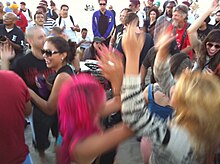This section needs additional citations for verification. (May 2024) |
A drum circle is an informal gathering of percussionists and dancers who meet in public for the purpose of playing drums and dancing. Often seen at parks and beaches. Percussionists usually gather in a circle and dancers are often seen in the centre of the circle. The participants make up the music as they go along, using their listening and playing skills to make musical connections and express themselves in any and all ways that feel right. Drum circles often attract both regulars and spontaneous participation and they can range in size from a handful of players to circles with thousands of participants. Defining values of a drum circle include equality, autonomy, inclusivity and freedom of expression.


The origins of contemporary drum circles in North America can be traced back to Congo Square in New Orleans, a pivotal site in the history of American music. During the French colonial occupation and before, this area was known as Bulbancha, a Choctaw/Chickasaw word meaning "place of many tongues," reflecting the diverse languages and cultures that converged there.
Congo Square was a unique space where enslaved Africans free people of color Native Americans and the allies of freedom would gather on Sundays to sell goods often to buy themselves from slavery which naturally led to drumming, dancing, and maintaining their cultural heritage. This tradition of communal music-making and the blending of various drumming styles—European marching drums, African rhythms, and Native American beats—laid the foundation for contemporary drum circles and influenced the development of numerous American music genres.
For an in-depth exploration of this history, the book Congo Square: African Roots in New Orleans by Freddi Williams Evans is highly recommended. It provides a detailed account of the cultural and musical significance of Congo Square and its lasting impact on the evolution of American music.
Drum circles went through a revival in the United States during the late 1960s and early 1970s for any group of people, particularly counterculture groups, who gather (informally) to play music together in public. The music is improvised and co-created by the participants. The music is always a group expression, not constrained by genre, instrumentation and not directed by one person or sub-group. Drum circles are leaderless.
In 1991, during testimony before the United States Senate Special Committee on Aging, Grateful Dead drummer Mickey Hart stated:
Typically, people gather to drum in drum "circles" with others from the surrounding community. The drum circle offers equality because there is no head or tail. It includes people of all ages. The main objective is to share rhythm and get in tune with each other and themselves. To form a group consciousness. To entrain and resonate. By entrainment, I mean that a new voice, a collective voice, emerges from the group as they drum together.[1]
Drum circles are a type of group drumming that have many benefits, including support, comradery, recreational music-making, wellness, learning, celebration, spirituality, and personal growth.
Over the decades, especially since the late 90's, other types of group drumming have been advertised incorrectly as drum circles leading to confusion regarding what a drum circle is. This has in some cases lead to real drum circles being banned by authorities who were under the impression that a drum circle is a commercial event and consequently regulating them with laws that are not applicable to gatherings.
- ^ Rhythm As A Tool For Healing and Health in The Aging process Archived 2011-07-23 at the Wayback Machine